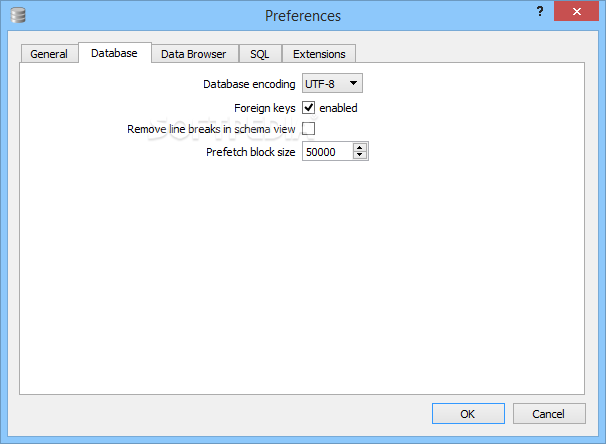

I guess I could require the install of a database server, but a commercial MySQL license doesn't make sense, PostgreSQL is different enough that I'd have to rewrite a lot of my application. I'd like to just be able to share the sqlite file on a network drive, but that would obviously result in corrupted data unless someone has any ideas. However, the application has grown, and now multiple users should be able to run the app and connect to one shared database.

It was a single user app, and the database sits right on the machine where the app runs.
#Use db sqlite windows#
You can view EDUCBA’s recommended articles for more information.I've written a Windows desktop application that works with Sqlite very nicely.

We hope that this EDUCBA information on “SQLite Create Database” was beneficial to you. From this article, we learned how and when we use SQLite to create a database. From the above article, we have learned the basic syntax of creating a database, and we also see different examples of creating a database. We hope from this article you have understood about the SQLite create database. Now we need to see the created database then, we can use the following command as follows.databasesĮnd result of the above command is shown in the below screenshot as follows. In the above example, we use the attach database command to create a new database name as Test. One more important thing here is the database name we refer to, as it is mentioned after the AS keyword as shown in syntax.Įxample ATTACH DATABASE 'test. In the above syntax, we use attach database command to create a database on SQLite here, the specified database name means the actual database name that we need to create. At that time, we can use the following statement as follows. db is an already created database now, we need to create another database.

End result of the above command is shown in the below screenshot as follows. cd SQLiteĪfter that, type the dir command to list the all available directory inside the SQLite folder. When we navigate inside the SQLite, then it shows something like the below screenshot as follows. We already discussed some steps about how we can open SQLite on cmd now let us see practically how we can create a database as follows.įirst, as per mentioned above, step on cmd and navigate to the user’s respective SQLite folder sometimes, the folder name may change depending on the user. Now let’s see the different examples of creating databases as follows. This component permits you to enter SQL orders that length numerous lines. In the event that you preclude the semicolon, sqlite3 will give you a continuation brief and hang tight for you to enter more content to be added to the current SQL order. Utilize interference with character (typically a Control-C) to stop a long-running SQL explanation.Įnsure you type a semicolon toward the finish of each SQL order! The sqlite3 program searches for a semicolon to know when your SQL order is finished. Type in SQL explanations (ended by a semicolon), press “Enter”, and the SQL will be executed.Įnd the sqlite3 program by composing your framework End-Of-File character (normally a Control-D). On startup, the sqlite3 program will show a concise pennant message at that point, brief you to enter SQL. In the event that no information base document is indicated on the order line, an impermanent data set is made, at that point erased when the “sqlite3” program exits. In the event that the named document doesn’t exist, another information base record with the given name will be made consequently.
#Use db sqlite zip#
Start the sqlite3 program by composing “sqlite3” at the order brief, alternatively followed by the name of the document that holds the SQLite information base (or ZIP file).
#Use db sqlite how to#
This record gives a concise acquaintance on how to utilize the sqlite3 program. The SQLite project gives a basic order line program named sqlite3 (or sqlite3.exe on Windows) that permits the client to physically enter and execute SQL proclamations against an SQLite data set or against a ZIP document. Once we are inside the SQLite, we can perform the create database operation and many more operations as per the requirement. After that, select the specified file and navigate where the sqlite3.exe is placed by using the command-line tool.ĥ. In the next step, find the desired SQLite location, which means it is located on the user machine.Ĥ. After that, cmd opens in the default folder of any machine.ģ. First, we need to open the command-line interface that is the cmd from the start and type their cmd and open it.Ģ. Now let’s see how we can create the database in SQLite as follows.ġ.


 0 kommentar(er)
0 kommentar(er)
